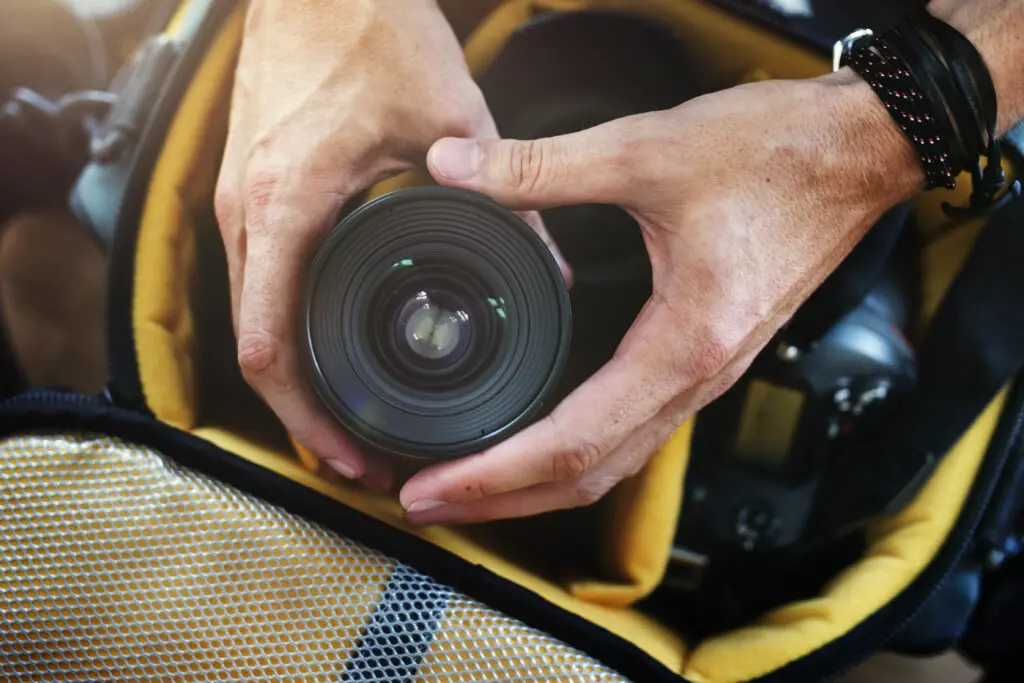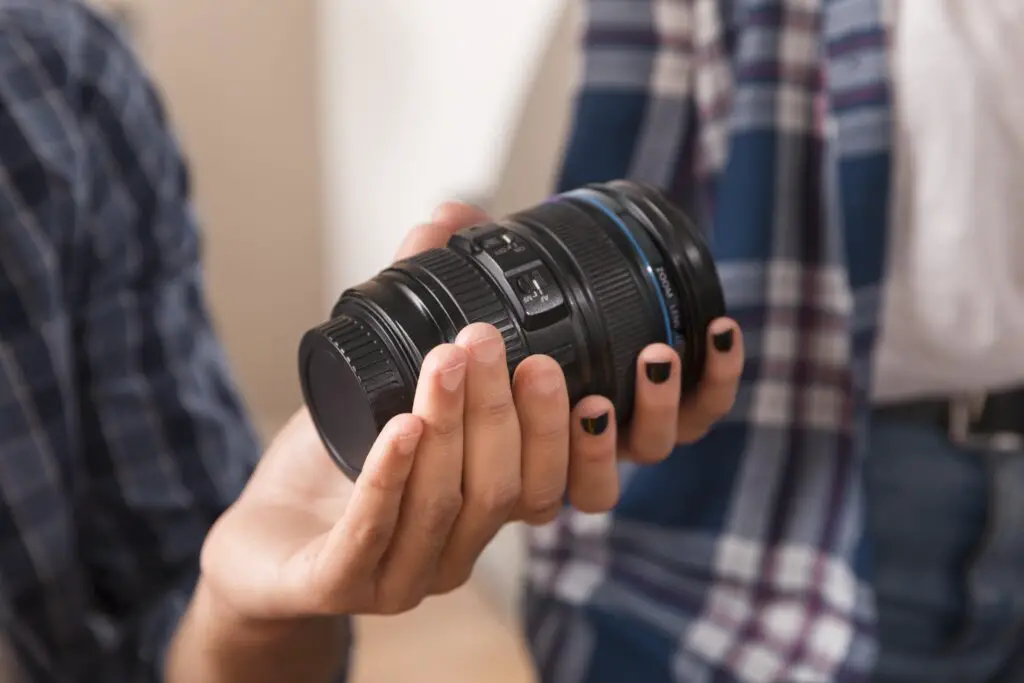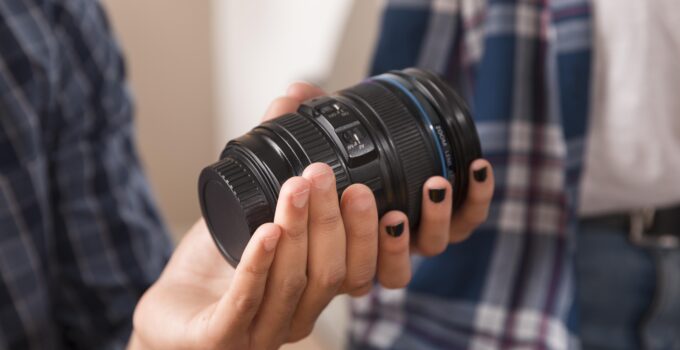Have you noticed smudges or dust affecting your photos? Cleaning your camera lens cover is essential for maintaining clear, sharp images.
Whether you’re using a DSLR, mirrorless camera, or even a smartphone, knowing the right techniques can prevent unwanted artifacts in your photos.
How do you effectively remove fingerprints, dust, and other debris without damaging the delicate surface of your lens cover?
Let’s explore some safe and effective methods to ensure your camera lens remains pristine and ready to capture every moment with clarity.”
Here how to clean a greasy camera body?
Can you clean a camera lens cover?
Cleaning a camera lens cover requires gentle handling to avoid scratches and damage.
Start by using a blower brush or compressed air to remove any loose dust and debris from the cover.

Next, use a soft microfiber cloth slightly dampened with lens cleaning solution or isopropyl alcohol (at least 70%) to gently wipe the surface in circular motions.
Avoid using excessive force or rubbing, as this could scratch the cover.
For stubborn smudges or fingerprints, moisten a corner of the cloth slightly and repeat the gentle wiping process. Ensure the cover is completely dry before reattaching it to the lens to prevent water spots.
Regularly cleaning the lens cover helps maintain clear, sharp photos and prolongs the life of your camera equipment.
How do you clean lens covers?
To clean lens covers effectively, start by removing any loose dust and debris using a blower brush or compressed air.
This prevents scratching during the cleaning process. Next, use a soft microfiber cloth specifically designed for cleaning lenses.
Lightly dampen the cloth with a small amount of lens cleaning solution or isopropyl alcohol (at least 70%) and gently wipe the lens cover in a circular motion from the center outward. Avoid applying too much pressure to prevent scratching the surface.
For stubborn marks or fingerprints, moisten a corner of the cloth slightly and repeat the gentle wiping motion.
Ensure the lens cover is completely dry before reattaching it to the lens to prevent water spots. Regularly cleaning lens covers helps maintain optical clarity and ensures your camera produces sharp, clear images.
Can I clean camera lens with alcohol wipe?
Using alcohol wipes to clean a camera lens is generally not recommended unless they are specifically designed for optical surfaces.
Standard alcohol wipes, such as those used for general cleaning, may contain harsh chemicals or abrasive materials that can damage lens coatings or scratch the glass.
If you must use alcohol wipes, ensure they are optical-grade and free from oils or fragrances that could leave residues on the lens. Before wiping, gently blow away any loose dust or debris to minimize the risk of scratching.
Use a light touch and gentle circular motions to clean the lens surface, starting from the center and moving outward.
After cleaning, allow the lens to air dry or use a soft, lint-free cloth to gently pat it dry. It’s best to use dedicated lens cleaning solutions and microfiber cloths designed for optics to safely maintain the clarity and performance of your camera lens.
Here, how to clean camera lens phone?
How do you clean camera lens cloth?
Cleaning a camera lens cloth is important to maintain its effectiveness and prevent it from transferring dirt or oils back onto your lenses.
Begin by washing the cloth by hand using a mild detergent or soap in lukewarm water. Gently rub the cloth between your fingers to dislodge any dirt particles. Rinse thoroughly to remove all soap residue.
Avoid using fabric softeners or harsh chemicals, as these can leave residues that may affect the cloth’s performance.
After washing, allow the cloth to air dry completely in a clean, dust-free area. Avoid drying it in direct sunlight, as this can degrade the fibers over time.
Regularly washing your lens cloth ensures that it remains clean and free from contaminants that could scratch your lenses. Store the cloth in a clean, dry case or pouch when not in use to further protect it from dust and dirt.
Can I use Windex on my camera lens?
Using Windex or other household glass cleaners on camera lenses is not recommended.
These cleaners often contain chemicals such as ammonia and alcohol, which can damage lens coatings and optical elements. Ammonia, in particular, can degrade lens coatings and affect the clarity of your images over time.
Instead, use lens cleaning solutions specifically designed for camera lenses. These solutions are formulated to be gentle and safe for delicate optical surfaces.
Apply the lens cleaning solution to a microfiber cloth designed for lenses, rather than directly onto the lens itself, to avoid excess liquid getting into the lens mechanism.
For stubborn smudges or fingerprints, moisten a corner of the cloth slightly with the cleaning solution and gently wipe the lens surface in circular motions.
Always use a soft touch to prevent scratching. Finish by drying the lens with a dry part of the cloth or allow it to air dry completely before using.
Taking these precautions helps maintain the optical quality and longevity of your camera lenses.
Things to know before cleaning a camera lens cover
Before cleaning a camera lens cover, it’s important to consider a few key points to ensure you do so effectively and safely:

- Inspect for Debris: Check the lens cover for any loose dust or particles. Use a blower brush or compressed air to gently remove these before cleaning to prevent scratching.
- Choose the Right Cleaning Tools: Use a soft microfiber cloth designed for cleaning lenses. Avoid using paper towels or tissues, as these can scratch the lens cover.
- Use Gentle Cleaning Solutions: Opt for a lens cleaning solution or isopropyl alcohol (at least 70%) to moisten the cloth slightly. Avoid using harsh chemicals or household cleaners that could damage lens coatings.
- Avoid Excessive Pressure: Use light pressure and gentle circular motions when wiping the lens cover. Too much pressure can scratch the surface.
- Dry Thoroughly: Ensure the lens cover is completely dry before reattaching it to the lens to prevent water spots.
By following these guidelines, you can effectively clean your camera lens cover without risking damage to your equipment.
Here, how to wear a masso shoulder camera bag?
How to clean a camera lens cover?
Cleaning a camera lens cover requires careful handling to avoid scratches and maintain optical clarity:
- Preparation: Start by inspecting the lens cover for loose dust and debris. Use a blower brush or compressed air to gently remove any particles.
- Choose Cleaning Tools: Use a clean, soft microfiber cloth specifically designed for cleaning lenses. Avoid using paper towels or rough fabrics that could scratch the surface.
- Moisten Cloth: If necessary, lightly dampen a corner of the cloth with a small amount of lens cleaning solution or isopropyl alcohol (at least 70%). Avoid applying liquids directly to the lens cover.
- Clean with Gentle Circular Motions: Gently wipe the lens cover in circular motions from the center outward. Use a light touch to avoid putting too much pressure on the cover.
- Dry and Inspect: Ensure the lens cover is completely dry before reattaching it to the lens. Inspect for any remaining smudges or marks and repeat the cleaning process if needed.
Regularly cleaning your camera lens cover helps maintain optimal image quality and protects your equipment from damage.
9 steps to clean a camera lens cover
Certainly! Here are the 9 steps to clean a camera lens cover, explained in detail:
Step 1: Gather Your Supplies
Before starting, gather all the necessary supplies:
- A blower brush or compressed air
- A clean, soft microfiber cloth
- Lens cleaning solution or isopropyl alcohol (at least 70%)
- Lens cleaning tissue (optional)
- Lens cleaning pen (optional)
Having these items ready ensures you can clean your lens cover effectively without needing to search for tools mid-process.
Step 2: Prepare the Work Area
Choose a clean and stable surface to work on. Ideally, work indoors to minimize dust and wind interference. Ensure there’s adequate lighting to see any smudges or dirt on the lens cover clearly.
Step 3: Remove Loose Debris
Inspect the lens cover for any loose dust, dirt, or debris. Use a blower brush or gently puff compressed air to remove these particles. This prevents them from scratching the lens cover during cleaning.
Step 4: Apply Cleaning Solution
If there are smudges or stubborn marks on the lens cover, lightly dampen a corner of the microfiber cloth with lens cleaning solution or isopropyl alcohol. Avoid using too much liquid; the cloth should be damp, not dripping.
Step 5: Wipe in Circular Motions
Using the dampened part of the cloth, gently wipe the lens cover in circular motions starting from the center and moving outward. This motion helps to lift dirt and oils without spreading them around.
Step 6: Use Lens Cleaning Pen (Optional)
For precise cleaning of corners or hard-to-reach areas, a lens cleaning pen with a retractable brush and cleaning tip can be helpful. Use the brush end first to remove any residual dust, then the cleaning tip if necessary.
Step 7: Inspect for Residue
After cleaning, inspect the lens cover under good lighting to ensure all smudges and marks have been removed. If there are stubborn spots, repeat steps 4 and 5 with a slightly dampened cloth.
Step 8: Dry Thoroughly
Once satisfied with the cleanliness, use a dry part of the microfiber cloth to gently pat the lens cover dry. Ensure it’s completely dry before reattaching it to the camera to prevent water spots.
Step 9: Store Properly
Store the microfiber cloth and other cleaning supplies in a clean, dust-free pouch or case. This prevents contamination and ensures they’re ready for the next use without needing additional cleaning.
Here, how do you clean a dirty camera body?
Following these steps ensures that your camera lens cover remains clean and free of scratches, preserving its optical quality for sharp, clear photographs. Regular cleaning also extends the lifespan of your camera equipment.
5 methods to clean a camera lens cover
Certainly! Here are five methods to clean a camera lens cover, explained in detail:

Method 1: Blower Brush and Microfiber Cloth
This method is gentle and effective for routine cleaning of camera lens covers:
- Blower Brush: Start by using a blower brush to remove any loose dust or debris from the lens cover. Hold the camera with the lens facing downwards to prevent debris from falling back onto the lens.
- Microfiber Cloth: Use a clean, soft microfiber cloth to gently wipe the lens cover. Microfiber cloths are designed to lift dirt and oils without scratching the surface. If there are stubborn smudges or fingerprints, breathe lightly on the lens cover to create moisture and use the cloth to gently wipe in circular motions from the center outward.
- Inspect and Repeat: After wiping, inspect the lens cover under good lighting to ensure it is clean. If necessary, repeat the process using a slightly dampened microfiber cloth with lens cleaning solution or isopropyl alcohol (at least 70%) to remove stubborn marks.
- Dry Thoroughly: Once clean, use a dry part of the microfiber cloth to gently pat the lens cover dry. Ensure it is completely dry before reattaching it to the camera to prevent water spots.
- Store Properly: Store the microfiber cloth in a clean, dust-free pouch or case to keep it free from contaminants for future use.
This method is safe for regular maintenance and helps maintain the optical clarity of your camera lens cover.
Here, how to clean rust from vintage camera?
Method 2: Lens Cleaning Solution and Tissues
For more stubborn dirt or grease on the lens cover, using lens cleaning solution and tissues can be effective:
- Apply Solution: Lightly dampen a lens cleaning tissue or cloth with a few drops of lens cleaning solution. Avoid applying the solution directly to the lens cover.
- Wipe Gently: Gently wipe the lens cover in circular motions from the center outward. Use a light touch to avoid applying too much pressure, which could scratch the surface.
- Inspect and Repeat: Check the lens cover under good lighting to ensure all dirt and smudges have been removed. If necessary, repeat the process with a fresh tissue or cloth.
- Dry Thoroughly: After cleaning, use a dry tissue or cloth to gently pat the lens cover dry. Ensure it is completely dry before reattaching it to the camera.
- Dispose of Used Tissues: Dispose of used tissues properly to prevent transferring dirt back onto the lens cover.
Using lens cleaning solution and tissues is effective for removing stubborn contaminants while minimizing the risk of scratches on the lens cover.
Method 3: Lens Cleaning Pen
A lens cleaning pen is handy for cleaning camera lens covers, especially in tight corners or around the edges:
- Brush Away Dust: Use the retractable brush end of the lens cleaning pen to gently brush away any loose dust or debris from the lens cover.
- Use Cleaning Tip: Extend the cleaning tip of the pen and gently rub it in circular motions on the lens cover to lift dirt and oils. Avoid using excessive force to prevent scratching.
- Inspect and Repeat: After cleaning, inspect the lens cover under good lighting to ensure it is clean. If necessary, repeat the process to remove any remaining smudges or marks.
- Store Properly: After use, retract the cleaning tip and cap the lens cleaning pen to protect it from dust and contaminants. Store it in a clean, dry place for future use.
Lens cleaning pens are portable and convenient for quick touch-ups on camera lens covers, ensuring they remain clean without needing additional tools.
Method 4: Lens Cleaning Wipes
Lens cleaning wipes are convenient for cleaning camera lens covers on the go:
- Select a Lens Cleaning Wipe: Choose a pre-moistened lens cleaning wipe designed specifically for cleaning camera lenses. Ensure it is free from harsh chemicals that could damage lens coatings.
- Wipe Gently: Remove the lens cleaning wipe from its packaging and gently wipe the lens cover in circular motions from the center outward. Use a light touch to avoid scratching the surface.
- Dispose of Used Wipe: Dispose of the used lens cleaning wipe properly to prevent transferring dirt back onto the lens cover.
- Dry Thoroughly: Allow the lens cover to air dry completely before reattaching it to the camera to prevent water spots.
Lens cleaning wipes are convenient for quick cleaning of camera lens covers while traveling or in situations where other cleaning tools may not be readily available.
Here, how to clean a underwater camera housing?
Method 5: Lens Cleaning Spray and Cloth
Using a lens cleaning spray and cloth provides thorough cleaning for heavily soiled camera lens covers:
- Spray Application: Spray a small amount of lens cleaning spray onto a clean, soft microfiber cloth. Avoid spraying directly onto the lens cover to prevent excess liquid from seeping into the camera.
- Wipe Gently: Gently wipe the lens cover in circular motions from the center outward. Use a light touch to avoid applying too much pressure, which could scratch the surface.
- Inspect and Repeat: After cleaning, inspect the lens cover under good lighting to ensure it is clean. If necessary, repeat the process with a fresh part of the cloth.
- Dry Thoroughly: Use a dry part of the microfiber cloth to gently pat the lens cover dry. Ensure it is completely dry before reattaching it to the camera.
- Store Properly: Store the microfiber cloth in a clean, dust-free pouch or case to keep it free from contaminants for future use.
Using lens cleaning spray and cloth effectively removes dirt, fingerprints, and oils from camera lens covers while maintaining their optical clarity and preventing scratches.
5 benefits to clean a camera lens cover
Certainly! Here are five benefits of regularly cleaning a camera lens cover, explained in detail:
Benefit 1: Maintains Optical Clarity
Cleaning your camera lens cover removes dust, fingerprints, and smudges that can degrade image quality.
Dust particles can obscure details and reduce sharpness, while fingerprints and smudges can affect light transmission and create unwanted artifacts in your photos.
By keeping the lens cover clean, you ensure that your camera captures clear, sharp images with accurate colors and contrast.
Benefit 2: Prevents Image Distortion
A dirty lens cover can cause light to scatter or reflect improperly, leading to lens flare, ghosting, or other optical distortions in your photographs.
These distortions can detract from the intended composition and impact the overall quality of your images.
Regular cleaning helps maintain the integrity of the lens cover’s optical surface, minimizing the risk of unwanted artifacts in your photos.
Benefit 3: Extends Lens Lifespan
Cleaning your camera lens cover regularly helps protect the lens itself from potential damage.
Dust and debris left on the lens cover can scratch the lens surface when wiped or blown away, especially if they contain abrasive particles.
By removing these particles promptly, you reduce the likelihood of scratches that could compromise the lens’s optical performance over time.
Here, how do you clean a canvas bag with leather strap?
A well-maintained lens cover contributes to the longevity and durability of your camera equipment, saving you from costly repairs or replacements.
Benefit 4: Improves Autofocus Accuracy
A clean lens cover allows your camera’s autofocus system to operate more accurately.
Dust or dirt on the lens cover can interfere with autofocus sensors, leading to slower focusing speeds or inaccurate focus points.
By ensuring the lens cover is free from contaminants, you help maintain the camera’s ability to achieve fast and precise autofocus, especially in challenging lighting conditions or when capturing moving subjects.
Benefit 5: Enhances Overall Shooting Experience
Keeping your camera lens cover clean enhances your overall shooting experience by reducing distractions and ensuring consistent image quality.
You can focus more on capturing the perfect shot without worrying about the impact of dirty lens cover on your photos.
Additionally, clean equipment reflects a sense of professionalism and care for your craft, which can positively influence your confidence and creativity during photography sessions.
By regularly cleaning your camera lens cover, you not only improve the quality of your photographs but also prolong the lifespan of your camera equipment, ensuring reliable performance for years to come.
Related faq’s
Can you wash a camera lens cap?
Yes, you can wash a camera lens cap. Use lukewarm water and a mild detergent or soap to gently wash the cap.
Use your fingers to rub off any dirt or grime, ensuring thorough cleaning. Rinse the cap well to remove all soap residue.
Pat it dry with a clean, lint-free cloth or allow it to air dry completely before attaching it back to the lens.
Avoid using harsh chemicals or abrasive materials that could damage the cap or its interior felt lining, which helps prevent light leaks when the cap is on the lens.
What liquid can you use to clean a camera lens?
You can use a dedicated lens cleaning solution designed specifically for camera lenses.
These solutions are formulated to be gentle and effective in removing smudges, fingerprints, and dirt without damaging lens coatings or optical elements.
Alternatively, isopropyl alcohol (at least 70%) can also be used sparingly to clean camera lenses, but it should be applied to a microfiber cloth rather than directly onto the lens.
Avoid using water or household cleaners, as they may leave residues or contain chemicals that could harm lens surfaces.
How do you clean a camera lens filter?
To clean a camera lens filter, start by using a blower brush or compressed air to remove any loose dust or debris.
Next, lightly breathe on the filter or use a small amount of lens cleaning solution or isopropyl alcohol (at least 70%) on a microfiber cloth. Gently wipe the filter in a circular motion from the center outward.
Avoid applying excessive pressure to prevent scratching. Inspect the filter under good lighting to ensure it’s clean, repeating the process if necessary.
Finally, use a dry part of the cloth to gently pat the filter dry or allow it to air dry completely before use.
How do people keep their lenses clean when they’re constantly touching them while shooting videos with their phone’s cameras?
To keep their lenses clean while shooting videos with phone cameras, people often use a microfiber cloth to gently wipe the lens periodically.
Some may use lens cleaning pens or lens cleaning wipes for quick touch-ups. Keeping the lens cover or cap on when not actively shooting can also prevent fingerprints and dust buildup.
Additionally, maintaining good hand hygiene and avoiding touching the lens directly can help minimize the need for frequent cleaning.
Regularly inspecting the lens and cleaning it as needed ensures clear, smudge-free footage without interrupting the filming process.
How do I clean off a camera lens when the dust is inside of the lens on the internal glass?
Cleaning dust from inside a camera lens, where it’s on the internal glass, typically requires professional servicing.
Attempting to clean it yourself can risk further damage or misalignment of internal components. Contact your camera manufacturer or a certified camera technician for proper disassembly and cleaning.
They have the tools and expertise to safely access and clean inside the lens without compromising its optical performance.
Avoid using compressed air or inserting any objects into the lens, as this can cause irreparable damage to delicate internal mechanisms.
Conclusion
Cleaning a camera lens cover is essential for maintaining clear, high-quality photographs.
Using gentle methods like a soft microfiber cloth and lens cleaning solution or isopropyl alcohol ensures effective removal of dust, smudges, and fingerprints without scratching the cover.
Regular cleaning not only enhances optical clarity but also prolongs the lifespan of your camera equipment.
Proper care, including storing the lens cover in a clean, dust-free environment when not in use, further protects it from damage.
By incorporating these practices into your routine, you can ensure your camera lens cover remains clean and ready for capturing perfect shots.









